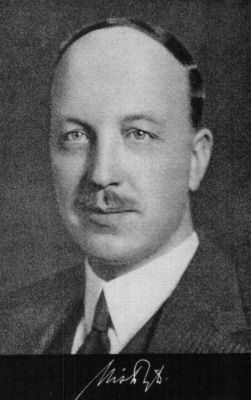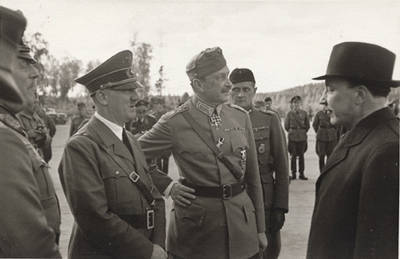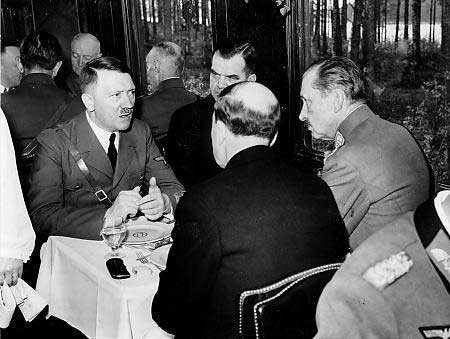<Back to Index>
- Mathematician Paul Samuilovich Urysohn, 1898
- Architect Jan Santini Aichel, 1677
- President of Finland Risto Ryti, 1889

Risto Heikki Ryti (February 3, 1889 - October 25, 1956) was the President of Finland from 1940 to 1944. He also served as Prime Minister (1939-1940). His time in office as President was marked by the Continuation War with the Soviet Union.
Risto Ryti was born in the Huittinen district of Satakunta, one of seven sons. His parents were Kaarle Evert Ryti, a farmer, and Ida Vivika Junttila. Although he came from a peasant farming background, during his childhood Ryti hardly participated in work on the family's large farm, being a bookish and academically inclined boy. He was educated briefly at Pori Grammar School, and was then tutored at home, before enrolling in the University of Helsinki in 1906 to study law.
After graduating in 1909, Ryti returned to his roots in Satakunta, where he established himself as a lawyer in Rauma. During this period he became acquainted with Alfred Kordelin- one of Finland's richest men. Ryti became his lawyer, and eventually the two men became close friends. During this period Ryti also undertook further studies, becoming a Master of Laws in 1912. In the spring of 1914 he moved to Oxford to study maritime law, but the outbreak of World War I forced him to return to Finland, where in 1916 he married Gerda Paula Serlachius (1886–1984). They had three children, Henrik (1916- ), Niilo (1919-1997), and Eva (1922-2009).
In
the period after the outbreak of World War I, before Finland achieved
its independence, Ryti's business relationship with Kordelin grew even
closer, and it appeared likely that Kordelin would ask Ryti to become
general manager of his numerous business enterprises. However, in
November 1917 Ryti and his wife witnessed the murder of Kordelin at the
hands of a Russian Bolshevik. During the Finnish Civil War Ryti played no active part, remaining in hiding with his family in the Red dominated Helsinki. Afterwards, however, he would become deeply involved in politics, being elected as a National Progressive member of Parliament,
at the age of thirty. He served as a member of parliament from 1919 to
1924 and from 1927 to 1929. During his first few years in Parliament,
Ryti served as chairman of the judiciary committee, and later the
finance committee. He also served as a member of Helsinki City Council
1924-1927. Ryti's personal political success continued even after
his liberal-oriented National Progressive Party shrank to a fringe
party, because he was considered an expert especially in economic
policy and, very importantly, as an impartial servant of the fatherland
who refused to play partisan politics. In 1921, the thirty-two-year-old Ryti was appointed as Finance Minister. He served in that position twice until 1924. In 1923 President Kaarlo Juho Ståhlberg appointed him as Chairman of the Bank of Finland,
a post he remained in until he became Prime Minister in 1939. In 1925 Ryti was also nominated as a presidential candidate but his opponents concentrated their votes on Lauri Kristian Relander.
His support increased over the years but was never enough in elections.
During the 1930s he withdrew from daily politics, but influenced
economic policies. In 1934 he was awarded the British honour of Knight Commander of the Royal Victorian Order (KCVO)
due to his great merits in Anglo-Finnish relations. Ryti was selected as prime minister at the beginning of the Winter War.
He tried to concentrate on a realistic analysis of the situation,
instead of pessimism or overt optimism. He persuaded the rest of the
Cabinet to settle for peace and was the one to sign the Moscow Peace Treaty on
March 13, 1940. The peace, in which Finland lost large land areas and
faced the burden of resettling 400,000 refugees, was generally
considered crushing. In the following precarious times Ryti bore the
heavy responsibilities of state leadership together with Field Marshal Mannerheim, industrialist Rudolf Walden and the Social Democratic leader Väinö Tanner as President Kyösti Kallio was struck by illness. As
a result, the duties of the president were transferred to prime
minister Ryti. Kallio never recovered and as the exceptional
circumstances, such as the lack of a permanent place of residence by
many Karelian refugees, prevented the
election of presidential electors, a constitutional amendment was
enacted by the Parliament of Finland to
enable the electors of 1937 to elect a successor to Kallio. Ryti won
the election with 288 votes out of 300. On the day of his retirement,
December 19, 1940, Kallio suffered a lethal stroke during a farewell
gathering. During Ryti's presidency the powers of the Commander-in-Chief remained with Mannerheim. Finland's changed policy from a Scandinavian orientation up to, and during, the Winter War, to a German orientation
after the Winter War, was not in the least pursued by the convinced
Anglophile Risto Ryti. Traditionally Finland had been associated with
Britain by stronger commercial ties, but as the Baltic Sea was
dominated by the Germans, lost markets had to be found elsewhere, and
Germans were willing to trade. The relatively limited space given to Nazi German
propaganda and ideology, or their domestic sympathizer fringe groups in
Finland, can probably be seen as one of the many important joint
contributions of Ryti, Tanner and Mannerheim. Ryti's government must
also be credited for the fact that Finland remained a genuine democracy
unlike any other continental European country that participated in WWII. In August 1940 Ryti also agreed to secret military cooperation with Germany, in order to strengthen Finland's position vis-à-vis the threatening Soviet Union. The cooperation begun in late 1940 ultimately
developed in 1941 into preparations for re-annexation of the
territories lost after the Winter War, in case Nazi Germany would
realize the rumoured plans for an assault on the Soviet Union. The
Continuation War, when it commenced, would also come to include
occupation of East Karelia, which Nationalist circles had championed since the 1910s. When
Germany's assault on the Soviet Union began in June 1941, Finland
remained formally neutral until Soviet air raids gave an expected
reason to fulfill the invasion plans some days later. Finnish troops
soon regained the territory lost in the Winter War and a substantial
buffer zone beyond. A substantial number of MP's were not excited by
the idea of crossing the old borders, but obviously Risto Ryti
convinced Väinö Tanner and the Social Democrats to remain in
the Cabinet despite their opposition to the conquest of East Karelia. Ryti's
mandate as President was intended to extend only through the rest of
Kallio's term, i.e., to 1943, but as the government could not organize
elections during the Continuation War, the electors from 1937 gathered
to re-elect him. This exceptional procedure was mandated by a
constitutional amendment passed by the Parliament of Finland.
To prepare Finland for the eventual peace negotiations with the Soviet
Union, the government was changed: Conservative Edwin Linkomies became
Prime Minister, some other ministers also came to the government and
the Patriotic People's Movement was excluded from the government. The
Soviet Union's major counter-offensive began in June 1944, in a
situation when Finland's relations to Germany were strained due to
earlier attempts to secure a separate peace. Finland was in dire need
of food, but in particular of weapons and ammunition, as the Nazi
Foreign Minister Joachim von Ribbentrop demanded guarantees that Finland would not again seek a separate peace. Ryti gave this guarantee, expressed as his personal guarantee that Finland under his presidency would
not. Soon after the situation was stabilized, Ryti resigned and peace
negotiations could begin again, this time from a stronger position
although most territorial gains had been lost by that time. Probably
neither Hitler nor any other German authorities read Ryti's letter
carefully enough, because Finland's decision at the start of September
1944 to end its informal military alliance or "brotherhood-in-arms"
with Germany surprised and angered them. None of them probably thought
that Ryti would resign any time soon, and thus give his successor a
free hand to break ties with Germany and to start peace negotiations
with the Soviet Union. After
the war Ryti attempted to return to the Bank of Finland. However, in
1945 Finnish communists and the Soviet Union demanded he should be tried as "responsible for the war".
This came as a shock to the Finnish people who held Ryti in high
esteem. After considerable pressure from the Soviet Union, Ryti was
sentenced to 10 years' imprisonment, in a trial widely held to be
illegitimate and a miscarriage of justice from the Finnish perspective.
Along with Ryti, seven other high officials were sentenced to prison,
although for shorter terms. Despite
Ryti and his fellow convicts not being treated particularly badly in
prison, Ryti's health failed during his sentence. Most of his stomach
had to be removed due to some tumour or other disease; in addition, he
developed arthritis during the first winter of imprisonment. He was pardoned by President Juho Kusti Paasikivi in 1949. In 1952, he attended a university students' celebration where he
accepted a badge of honour. In
May 1956, just five months before his death, he received an honorary
doctorate in political science from the Helsinki University. Risto Ryti died in
October 1956 and was buried with full presidential honors. In 1994, a statue of Ryti was unveiled near the Finnish Parliament House. In 2004, in the YLE TV-series Suuret Suomalaiset (Greatest Finns) Risto Ryti got the second highest number of votes.

